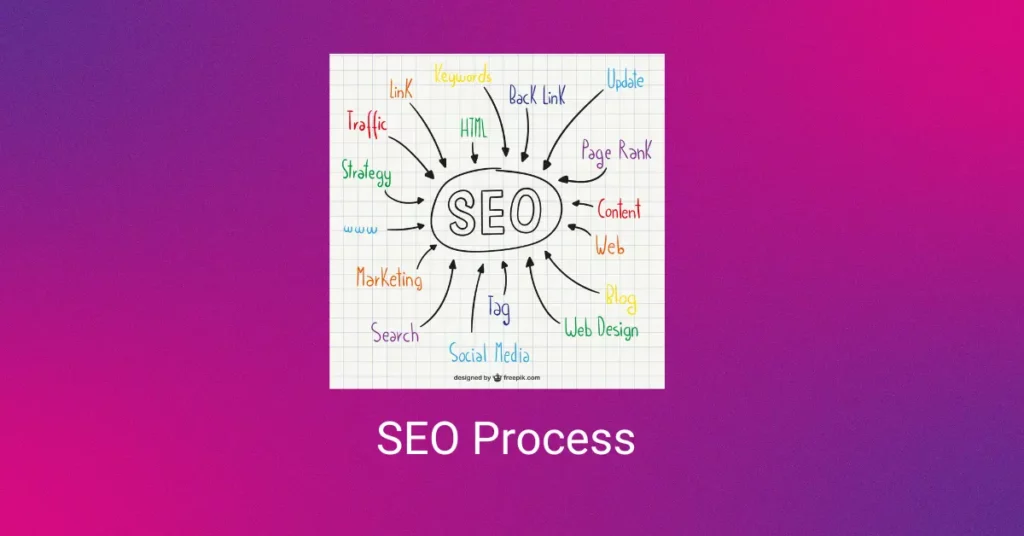Search engines are one of the best platforms to promote your business and attract customers. But are you visible to your target audience when they search for your niche-specific product or service online? Or are you nowhere to be seen?
Your visibility on search engine results pages decides your online fate. You could have the best website and content. However, if no one sees them, all your hard work can be wasted. This is where Search Engine Optimization (SEO) comes into play.
The SEO process is a combination of tactics you apply to improve your site’s visibility in SERPs. It is an excellent way to ensure your audience sees and engages with you while searching online.
What are the SEO process steps?
SEO is an effective digital marketing strategy to expand your reach between the sea of websites. If you do it the right way, SEO can do wonders for your brand. You can build ever-lasting relationships with your audience and grow your business in the long run.
However, SEO is not a one-time practice. It needs continuous effort to beat your competition. Various tools and techniques come into play to achieve success. You must stay alert considering the never-ending changes in search engine algorithms, devices and user behaviour. Most importantly, you must understand all SEO process steps in detail to chalk out an effective strategy.
This article discusses SEO process steps that can help boost your credibility, search engine rankings and revenue. Let’s get started.
Keyword research
Keyword research is the foundation of your SEO strategy. It unveils the needs of your target audience. With robust keyword research, you can discover what exactly your audience is searching for. This helps in creating content that suits their needs. But how can you find keywords for your content?
You can use tools like Google Keyword Planner, Long Tail Pro, SEMrush, Ahrefs, etc. They can help you identify the monthly search volume and ranking difficulty for each term or phrase.
Once you have a list of keywords to embed in your content, divide them into primary and secondary. Primary keywords are the ones you want to rank for. On the other hand, using secondary keywords can give search engines extra information about your content.
Besides keyword research, you must also understand the intent behind a search query. This makes it easier to create the most suitable content for your target audience. For example, writing long-form blog posts is ideal if users want information on a topic. However, if the search intent is transactional, creating product pages can get you more traffic.
Competitive research
The next step in the SEO process is to analyze what your competition is doing to rank. A little research on your competitors can help you know the areas where they are doing better than you. This allows you to meet user expectations and fill in the gaps in your strategy.
Competitive research is an excellent way to perform content gap analysis. It helps discover the keywords your competitors are ranking for and what content type is doing well. By keeping an eye on the top-performing pages, you can leverage their plus points and improve your rankings.
On-page optimization
On-page optimization, as the name suggests, is optimizing your site’s on-page aspects. It helps ensure users can easily access and navigate your site on multiple devices. In addition to enhancing user experience, on-page optimization gives search engines an insight into your content so that it can be ranked.
A few components involved in on-page optimization include publishing quality content, embedding the right keywords, optimizing HTML tags, and internal links, and more.
Site architecture
Categorizing, linking and structuring your site content can play a great role in your search engine rankings. It is important to organize your pages well so that users and search engines do not get confused.
You can optimize the site structure by submitting an XML sitemap. A sitemap acts as a map of your site. It tells search engines which pages are essential and must be crawled. So, even if you have not interlinked the pages, a sitemap ensures that search engines crawl and index all essential pages of your site.
However, internal linking is another crucial thing to optimize your site structure. It helps users navigate your website easily and allows search engines to crawl, index and rank your pages.
Technical SEO
Another essential step in the SEO process is to make your site technically sound. You can start with a technical audit. It helps you analyze the technical elements of your site to rank well. Here’s a list of technical elements you should optimize:
- Site speed
Improving your site speed is one of the most important steps in technical SEO. Today, users have a short attention span. Any anomaly in their online journey can frustrate them. According to data, for each extra second, a page takes time to load, conversion rates fall by 4.4%. Hence, ensuring your website works fast is critical to avoid high bounce rates.
Some steps you can take to reduce page load speed include optimizing CSS, JavaScript, HTML code, compressing your images and more. Google PageSpeed Insights tool can also help you analyze and optimize your website’s speed.
- Indexability
Google first crawls a page before adding content to its database or index. Indexability thus refers to how easily search engines can add a webpage to their index so that it appears in the SERPs. So how can you make your page indexable?
To ensure your pages are indexed by search engines, it is important to submit a sitemap and internally link your pages. But what about the pages you don’t want search engines to add to their database? These can include non-public pages, PDFs or other resources. In such cases, you can create a robots.txt file to tell search engines not to index a few pages or sections.
- Mobile responsiveness
Most of the searches are now done on mobiles. This makes it crucial to make your website mobile-friendly. Here’s how you can do this:
- Create a responsive layout
- Compress images
- Avoid pop-ups
- Ensure thumb-friendly navigation
- Improve site speed
- Space out links
- Ensure call-to-action (CTA) buttons are prominent
- Use readable and bigger font
Content Strategy
Publishing high-quality and engaging content regularly can do wonders for your online presence. Content strategy involves planning, creating, publishing and auditing your content. With a good content strategy, you can drive and engage your audience and meet their needs. So, how to begin with a content strategy? Here’s how:
- Define your goals
- Study your target audience
- Understand search intent
- Carry out a content audit
- Pick a content management system
- Decide on which type of content you wish to create
- Carry out a content gap analysis
- Think about content ideas
- Publish, manage and update your content
At the same time, make sure your content is accurate, engaging, simple to read and free from grammatical or spelling errors.
Link building
Link building is when you get other websites to link to yours. Search engines view such links as “votes of confidence”. The more you get other sites to link to your site, the more trustworthy and authoritative you become for users and search engines. And the more authoritative and credible you become, the higher you rank in SERPs.
So, make sure you work hard on your link-building strategy. It is one of the most effective ways to boost your online visibility. A common link-building technique is guest posting. You can write posts for popular websites and ask for links to your site in return. Creating surveys, sharing content on forums, and collaborating with opinionated leaders are some other ways of earning links.
Conducting a backlink analysis of competitors’ websites can also give link-building ideas and help you compete in your industry.
Local SEO
You may lose many customers and revenue if the local audience doesn’t find you on the SERPs. Hence, improving your visibility online is essential if your business operates in a geographical location. And when it comes to local SEO, setting up and optimizing Google Business Profile is the first step to begin with.
Google Business Profile is a free tool. It can boost your SEO effort. It helps users identify your business by providing details like its location, opening hours, contact information, photos and more. You can also optimize local SEO by targeting local keywords in your content and getting high-value backlinks.
Reporting and maintenance
SEO is not a one-time exercise. It needs coherent research, testing and evaluation. Once you have put in the right effort, it is important to put in place a reporting and maintenance system. This helps ensure everything is going as planned.
Regular monitoring and reporting on metrics like traffic, rankings, conversion, etc. can help you achieve success in the long run. It also helps identify and correct issues at the right time to beat your competition.
Conclusion
The SEO process is a constant battle to drive your audience’s attention and rank higher in SERPs. It is all about research, optimizations and audits to keep up with search engine algorithms, industry trends, and user demand.
Another crucial thing to keep in mind is that the SEO process takes time to show results. You may only achieve the desired results after a while. All you need is the right strategy, hard work, constant monitoring and patience to achieve long-term success in the digital landscape.
Popular Searches
How useful was this post?
0 / 5. 0

















